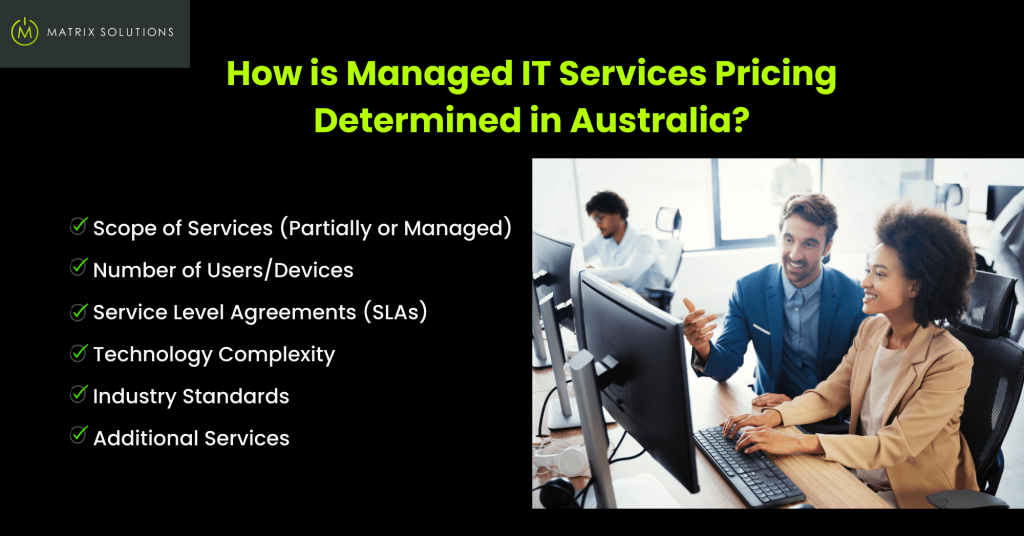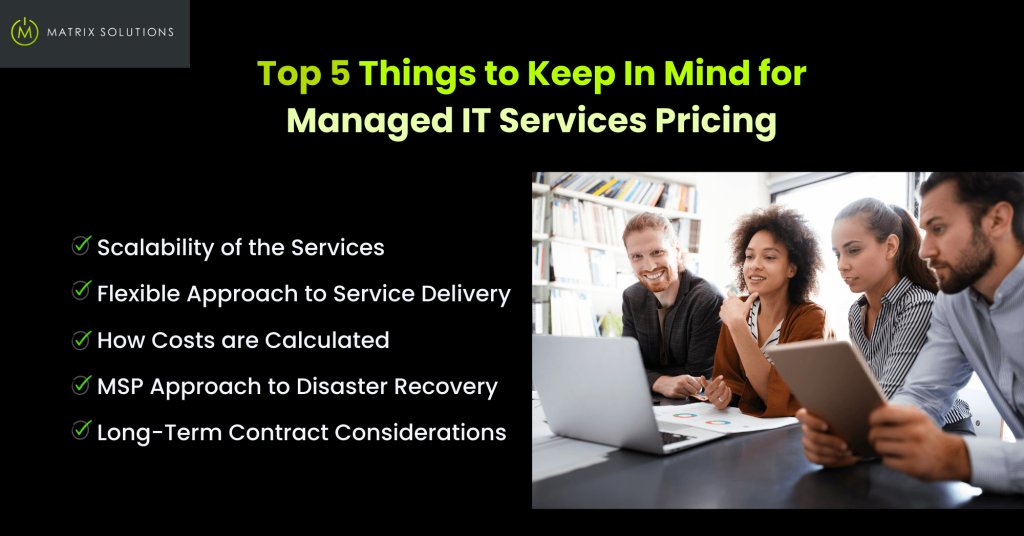Each business has unique needs, and contracts vary. Our Managed IT Services Pricing Guide sheds light on how price varies considering factors like IT environment size, complexity, and included services.
Today, almost every business relies on IT for daily operations and customer service. Unexpected IT problems can disrupt work and lead to costly downtime. The solution is outsourcing to a managed IT services provider. However, determining the needed services and their costs can be challenging, as managed IT services pricing is a complex and often elusive topic.
Hiring managed IT services offers cost savings by eliminating the need for a full-time IT team. Business owners considering this should understand local pricing models for informed decisions. Flexible MSP pricing aligns with your business priorities and budget. Here’s a quick look at the common pricing models for managed IT services and factors that impact pricing in Australia.
Key Takeaways
- Flexible Pricing Models: Common MSP pricing options include break-fix, flat-rate, per-user/device, and hybrid models—each catering to different support needs and budgets.
- Factors Influencing Cost: Pricing is determined by scope of services, number of users/devices, technology complexity, SLA requirements, additional services (like cybersecurity), and industry compliance standards.
- Typical Pricing Range: In Australia, SMBs generally pay between $100–$300 per user/month, while larger organisations may exceed $500 depending on service levels and complexity.
- Scalability & Transparency Are Key: Choose MSPs offering scalable solutions and clear, upfront pricing to avoid hidden costs and ensure adaptability as your business grows.
- Matrix Solutions Advantage: As a trusted MSP and NetDocuments Platinum Partner, Matrix delivers custom, fully managed IT services for professional sectors—backed by transparent pricing and expert support.
What is Managed IT Services?
In simple terms, managed IT services means outsourcing a company’s IT management and support to a third-party provider. This model benefits small and medium-sized businesses without the resources for an in-house IT team. The aim is to provide reliable IT support, reduce costs, and allow companies to choose fully managed or partially managed services based on their specific needs. This approach frees up internal IT teams for strategic projects, promotes business growth, and offers proactive monitoring, maintenance, and support for secure and optimised systems without needing in-house IT staff.
What Services Should an MSP Offer?
As a Managed Service Provider (MSP), we consider offering the following key services to our clients:
- IT Infrastructure Management
- Help Desk Support
- Proactive Maintenance and Support
- Data Backup and Disaster Recovery
- Managed Security Services
- Cloud Services
- Network Monitoring and Management
- Document Management
- Vendor Management
- IT Consulting and Strategy
Common Managed IT Services Pricing Models
If considering outsourcing your IT needs to an MSP, you must understand the different pricing models available. When you look at IT services for your organisation, you need to consider how much they cost. It is important because it affects the choices you make.
Here are some of the most common managed IT services pricing models to help you make the right choice:
1. Break-fix Model or Hourly Rates
The break-fix model, also known as the hourly rate model, is a conventional pricing approach in which businesses compensate for services as needed. This model is well-suited for enterprises experiencing periodic IT issues or those needing minimal support.
2. From-To Model
The from-to-pricing model comprises a structured payment framework for services within a specified range. For example, a business may opt for a fixed monthly fee of $1500, covering services of up to 30 hours of support per month. This pricing model suits enterprises with regular IT support demands and foreseeable service requirements.
3. Flat Rate Model
The flat-rate pricing model offers businesses the convenience of a fixed rate paid to the Managed Service Provider (MSP) for a comprehensive range of services. This pricing structure is especially beneficial for enterprises with predictable needs looking for all-encompassing IT support.
4. User/Device Per Month
The user/device per month pricing model offers businesses a fantastic opportunity to manage costs effectively. Under this model, companies can enjoy the benefits of a fixed rate per user or device per month, making budgeting more predictable. It becomes especially advantageous for businesses with a large user base or numerous devices requiring consistent IT support, building a positive and streamlined approach to financial planning.
5. Hybrid
A hybrid pricing model is a dynamic strategy that combines two or more pricing models to meet a business’s unique needs. For example, an organisation may enjoy a flat rate for basic services coupled with the flexibility of an hourly rate for additional support, creating a harmonious balance that promotes positive outcomes.
How is Managed IT Services Pricing Determined in Australia?

You must be wondering how Managed Service Providers determine their price in Australia. You must understand how managed IT services are priced if you consider outsourcing your IT needs to an MSP. Knowing what affects the cost of IT services can help you make a smart choice and get the most value for your money.
Let’s explore some key factors that determine the managed IT services pricing in Australia:
1. Scope of Services
The scope of services that your organisation requires will impact the pricing of managed IT services. Models such as 24/7 support or on-demand assistance may incur different costs. So, it is important to consider your business’ specific needs when you choose a model that aligns with your requirements. MSPs offer many types of services, including:
Partially Managed Services
Partially managed services involve outsourcing specific tasks to a third party while maintaining internal control over other sensitive aspects. These services include IT support and infrastructure management, security updates, data backup and recovery, optimising resource allocation, and focusing on core business objectives.
Fully Managed Services
Fully managed services involve an MSP responsible for the end-to-end service or infrastructure management. It allows clients to focus on their core business activities. At the same time, MSPs provide comprehensive IT support, including proactive maintenance and support, cloud computing, cybersecurity, data backup and recovery, and helpdesk support.
Managed Infrastructure
Managed infrastructure is a service model where a third-party provider manages physical hardware and software assets, including servers, storage, and networking components. This outsourcing allows businesses to focus on their core activities while MSPs ensure the performance of their physical infrastructure.
2. Number of Users/Devices
The number of users or devices supported influences the pricing structure of Managed IT Services. Companies with more users or devices can expect to incur higher costs than those with a smaller user/device base.
3. Service Level Agreements (SLAs)
Service-level agreements (SLAs) define the extent of service the managed service provider (MSP) offers. These agreements usually include response times, assurances of uninterrupted service, and various other metrics related to service quality. The cost of managed IT services tends to increase with higher SLA requirements, reflecting a proportional relationship between service expectations and pricing.
4. Technology Complexity
The technology complexity of a business’s infrastructure influences the pricing of Managed IT services. Companies with more complicated infrastructures will need higher-level support, resulting in higher costs than those with simpler infrastructures.
5. Additional Services
Additional services like cybersecurity or data backup and recovery influence the pricing structure of Managed IT Services. Clients in need of extra services can expect to pay a higher fee compared to those seeking only basic services.
6. Industry Standards
Industry standards can influence the pricing of Managed IT Services. For example, in heavily regulated sectors, businesses might need extra security measures, which can impact the cost of Managed IT Services.
What is the Estimated Managed IT Services Pricing?
As previously discussed, the estimated managed IT services pricing can vary significantly, influenced by factors such as the scope of services provided, the number of users/devices supported, SLA requirements, technology features, additional services needed, and adherence to industry standards. The monthly cost estimate for managed IT services spans from a few hundred to several thousand dollars per user or device. The anticipated range for small to medium-sized businesses (SMBs) is typically between $100 and $300 per user per month. In contrast, larger enterprises with more extensive requirements may face costs exceeding $500 per user or even higher.
It’s essential to recognise that these are broad estimates, and actual pricing can be affected by factors such as the level of service, IT environment complexity, and additional features like cybersecurity measures and cloud integration. According to a survey conducted by Techaisle, the average monthly cost of managed IT services per user in Australia falls within the range of $100 to $200. Nevertheless, the exact price will fluctuate based on the factors above.
Things to Keep In Mind for Managed IT Services Pricing

Integrating managed IT services into your business requires careful attention to pricing nuances. It would help if you balanced budget constraints and high-quality service delivery. Thus, when considering managed IT services pricing, businesses should be mindful of several key considerations:
1. Consider the Scalability of the Services
You must assess your MSP’s scalability to ensure alignment with your business’s evolving needs and growth. Ensure your MSP can accommodate changes in the business’ technology infrastructure without disrupting ongoing operations.
2. Flexible Approach to Service Delivery
You must seek a managed service provider that provides adaptable service delivery options tailored to your company’s unique requirements. It may require supplementary support during peak operational periods or outside standard business hours.
3. Understand How Costs are Calculated
It would help if you had a comprehensive understanding of how your MSP calculate costs to mitigate the risk of unexpected charges or fees. Your MSP must provide a transparent pricing structure, clearly mentioning any additional costs associated with specific services.
4. Assess the MSP Approach to Disaster Recovery
As a business owner, you must assess your MSP’s disaster recovery approach to ensure that they have effective measures for addressing potential outages or disasters. Ensure your MSP has a thorough and well-documented disaster recovery plan that includes data backup and recovery procedures.
5. Evaluate Long-Term Contract Considerations
Before signing an agreement with an MSP, you must evaluate long-term contract considerations. The contract should be flexible enough to adapt to your business’s technological infrastructure changes. It should also include clear contract termination clauses.
Transform Your Business with Matrix - The Best Managed Service Provider
Transform your business with Matrix Solutions – the best managed service provider. We offer top-tier IT services, specialising in hosted desktop and network management solutions for professional firms. Focus on your business and build long-term client relationships with us. We excel in installing and supporting NetDocuments document management software as a NetDocuments platinum partner. Our managed IT services cover cloud, outsourcing, and security services, ensuring your IT infrastructure’s optimisation, security, and compliance.
Matrix Solutions offers complete Managed IT Services, including cloud backup, disaster recovery planning, cybersecurity, and more. We provide hardware/software supply, M365/O365 tenancy setup, domain registration, website hosting, VoIP installation, and more. Whether for strategic planning or daily IT support, empower your business with us. Contact us today!
FAQs:
Can managed services reduce total IT costs?
Managed services can reduce total IT costs by outsourcing certain IT functions to MSPs. These specialised providers help improve efficiency, reduce downtime, provide proactive maintenance and support, and offer access to advanced technologies, thereby reducing costs.
What is the average profit for Managed IT Services?
The average profit for managed IT services depends on various factors, such as the size of the MSP, the scope of services provided, and market conditions. Profit margins can range between 10 and 40%, with some MSPs achieving higher margins through efficient operations and value-added services.
Why get a managed IT service?
Managed IT services offer organisations a range of benefits, such as enhanced efficiency, cost savings, proactive maintenance, access to expertise, and increased focus on core business activities. By outsourcing IT management to specialised MSPs, businesses can streamline operations, reduce downtime, improve overall efficiency, provide access to advanced technology, and stay competitive in the rapidly evolving landscape.
Who needs managed IT services?
Managed IT services benefit almost all businesses that require reliable and efficient IT support while reducing costs associated with maintaining an in-house team. They are also valuable to small businesses that need an in-house IT department and larger enterprises seeking to augment their existing IT capabilities.







